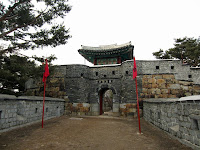The gates and walls I saw on our way back from Everland Resort to Suwon made me want to go back and take a closer look. So after three weeks, I was successful in dragging my husband to Suwon Hwaseong Fortress.
 This area was surrounded by 5.7 kilometers of stone walls and has four gates, the Janganmun (north gate), Hwaseomun (western gate), Changnyongmun (eastern gate) and the Paldalmun (southern gate) and has towers used for different purposes. The fortress was influenced by both Eastern and Western architecture. It was built before the end of 18th century when King Jeongjo tried to move the capital from Seoul to Suwon to get away from the ugly memories of his father, Prince Sado's death caused by his grandfather King Yeongjo. The Crown Prince was locked in a rice chest for eight days until he died. King Jeongjo moved his father's tomb to Suwon and built these walls to protect it. Now, it's in the list of UNESCO's world heritage sites.
This area was surrounded by 5.7 kilometers of stone walls and has four gates, the Janganmun (north gate), Hwaseomun (western gate), Changnyongmun (eastern gate) and the Paldalmun (southern gate) and has towers used for different purposes. The fortress was influenced by both Eastern and Western architecture. It was built before the end of 18th century when King Jeongjo tried to move the capital from Seoul to Suwon to get away from the ugly memories of his father, Prince Sado's death caused by his grandfather King Yeongjo. The Crown Prince was locked in a rice chest for eight days until he died. King Jeongjo moved his father's tomb to Suwon and built these walls to protect it. Now, it's in the list of UNESCO's world heritage sites. |
| Dongbuk Gangnu |
That was just the beginning of a long, tiring hike up the mountain. We followed the wall, taking 2-minute breaks each time we're out of breath and finally reached the highest part (or so we thought). There's another pavilion, a tower, some benches and a nice view of Suwon.
 |
 |
| Seoammun |
 |
| Filial Piety Bell |
 |
| UNESCO stone marker |
 |
| gate going to the convenience store |
 |
| gate and muddy trail to Seonamgangnu |
Hwaseong Haenggung is a temporary shelter where the king
used to rest or retire from a war. This is the biggest among the temporary palaces built in South Korea. The king stayed here at the time of Wonghaeng (his long journey) and this is where his mother's 60th birthday was celebrated.
 |
| Hwaseong Haenggung |
 |
| King Jeongjo's Statue |
 |
| gallery behind the statue |
HOW TO GET THERE
Subway Line 1, Suwon station (exit 2)
take bus #2, 7, 7-2, 8 or 13 to Jongno 4-geori
OPERATING HOURS
Summer- 9am to 6pm
Winter - 9am to 5pm


No comments:
Post a Comment